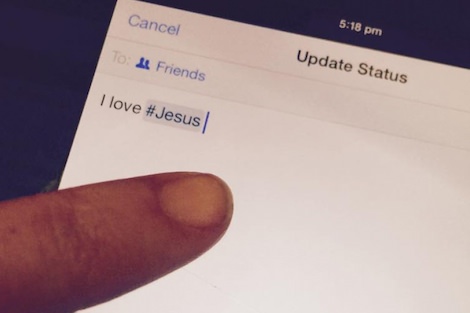 The opening Gospel reading for Lent always makes me chuckle a little bit:
The opening Gospel reading for Lent always makes me chuckle a little bit:
'Beware of practicing your piety before others, And whenever you pray, do not be like the hypocrites; for they love to stand and pray in the synagogues and at the street corners, so that they may be seen by others. And whenever you fast, do not look dismal, like the hypocrites, for they disfigure their faces so as to show others that they are fasting.' (Matthew 6:1 - 8)
Of course, immediately after that Gospel reading, people are marked with ash on their foreheads, then sent out into the world, with marks of their piety on their faces.
I saw a few people at the start of Lent pointing out this reading and making fun of people who posted selfies of themselves with ash on their forehead using the #ashtag tag on Twitter: Did they not realise that Lent isn't about them, but about God? Why did they have to turn it into self-promotion?
This, too, made me chuckle a little bit. I wondered if those people made sure to wipe off all the ash from their forehead before they left the church on Ash Wednesday, so they couldn't be accused of self-promotion as they went about the rest of their day.
As someone who posted an #ashtag selfie, and who actually liked the idea, it got me thinking about the difference between marking yourself as one of the faithful, and the sort of person the Gospel reading is describing.
The main reason I posted an #ashtag selfie on Twitter was because there was a large part of me that was embarrassed to do so. As we know, it's not an easy time for someone to be Catholic these days. I was afraid that 'outing' myself as a practising Catholic would make my non-Catholic followers think less of me. That fear, I realised, was something of the self - it wasn't of God.
Even if I'm open about my faith in my Twitter bio, it's not something I put in front of people all the time. Yet God is very much a part of everything that I am. My faith is a lens through which I enjoy most of the things I tweet about - football, basketball, soccer, TV shows - and why the other half of my Twitter feed tends to be full of posts about social justice issues and politics. I don't always put God front-and-centre in my feeds because I've learned that it's a quick way to alienate people without faith from a conversation. But I still endeavour to ensure that what I post on social media is in line with my faith.
Ash Wednesday, and the #ashtag selfie post, was for me a way to set myself aside and show people that God was an important part of my life and who I am. Rather than turning Ash Wednesday into something about me, it was about setting myself aside for a moment and pointing people towards God. It was also about encouraging other people of faith who have few others around them to share that faith with. Posting those pictures online was a way to help those people not feel so isolated.
Contrast that to the sort of person talked about in the Gospel reading: People who turn up to church on Sunday simply because it brings esteem, and who make a great deal of their sacrifices to make others feel inadequate. Few young people in Australia are going to hold their friend in awe because they go to church on Ash Wednesday. And given most of their friends will be indulging in Easter eggs guilt-free for the next few weeks, it's unlikely their Lenten sacrifice will have much effect on the people around them.
The #ashtag campaign has inspired me this Lent to try to be more open about my relationship with God in my life and in my posts. My act of penance in Lent is to take myself more away from the social media space, and put God there more often in my posts. The #ashtag selfie is the first step of that, for me. I pray that more steps will follow.
Michael McVeigh is editor of Australian Catholics magazine, and can be found at @mjmcv on Twitter.